Hina Matsuri
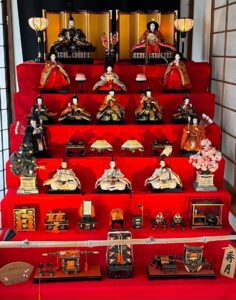
A lavish display of hina Nin-gyō, 雛人形, chick Person-form, dolls modeled on Japan’s Heian imperial court displayed on a seven-tier stand, with the emperor and empress on the top tier. Such a collection is given to celebrate the birth of a girl, and there are countless variations on this particular scene and arrangement of the dolls. Every year on the third day of the third month the dolls are displayed for the celebration of Hina Matsuri, 雛祭, Doll Festival. The dolls are for display only, but because children love to play, often a little girl’s much-loved doll might join the scene. Note the Tea utensils on the right side of the step above the bottom, and the pink and white kagami mochi, 鏡餠, mirror-mochi, and the five-color hishi-mochi, 菱餅, rhombus-mochi.
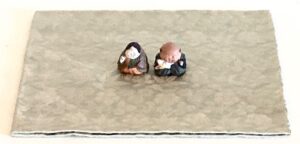
Mame nin-gyō, 豆人形, bean person-form; use of the term mame, bean, means very, very, small. The tiny dolls are ceramic, cold-painted figures of O-ta-fuku, お多福, O-much-fortune, and Fuku-suke, 福助, Fortune-help; the dolls are fully formed and colored on the bottom as well; the height of each figure is 6 bu kane-jaku. The dolls displayed on a ko-buku-sa, 古帛紗, old-cloth-gauze, silk don-su, 緞子, damask-of, with pattern of shō-chiku-bai, 松竹梅, pine-bamboo-Japanese apricot; 5 x 5.2 sun kane-jaku, by Toku-sai, 徳斎, Virtue-abstain, Kyōto.
The tiny couple, Otafuku and Fukusuke, may evoke the emperor and empress of the familiar Japanese Doll Festival dolls. These treasures are not toys. Like many figures of important deities and revered spirits, they are to be appreciated by their very presence, and not played with. Such things are called oki-mono, 置物, place-thing.
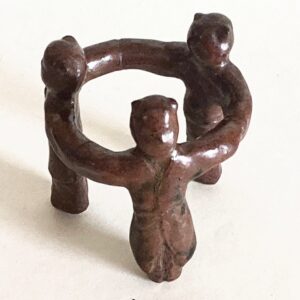
This object was based on a small ya-gaku, 夜学, night-study, to support an oil lamp dish. The image of three children is based on a Chinese motif of three Kara-ko, 唐子, Tang-child, that were depicted cavorting around a fish bowl, breaking it on occasion. More importantly, it is one of the seven objects that Rikyū chose to use as a futa-oki, 蓋置, lid-place. Its ancient association with water ideologically protects against fire. It is one of the few futaoki that is not inverted when used to support the kettle lid.
Hina-matsuri, 雛祭り, Doll-festival is traditionally held on the 3rd day of the 3rd month according to the lunar Kyū-reki, 旧暦, Old-calendar. However, in modern times, the festival is held on March 3. This event is more correctly identified as Momo no Se-kku, 桃の節句, Peach’s Season-phase.
Momo no Se-kku is one of the Go-se-kku, 五節句, Five-season-phase, which is more traditionally called Jō-shi no Se-kku, 上巳, の節句, Upper-snake’s Season-phase. The Five Seasons were established in the Nara period, and particular plants were associated with the season:
1st month 7th day – Nin-nichi, 人日, Person-day, nana-kusa, 七草, seven-grasses, spring herbs in rice gruel.
3rd month 3rd day – Jō-shi, 上巳, Upper-snake, momo, 桃, peach blossoms.
5th month 5th day – Tan-go, 端午, Edge-horse, shō-bu, 菖蒲, iris-bulrush, wordplay on 勝負, victory-defeat.
7th month 7th day – Tanabata, 七夕, Seven-night, take, 竹, bamboo.
9th month 9th day – Chō-yō, 重陽, Multi-Yang, kiku, 菊, chrysanthemum flowers resemble the sun and its radiances.
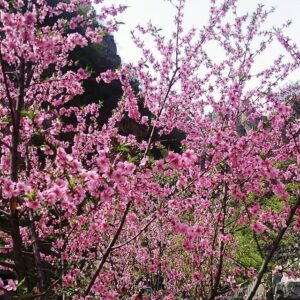
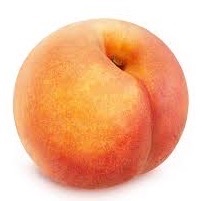
The peach and its flowers are highly prized in China, and may be regarded as a classic Chinese motif. Aside from its natural beauty and vast variety, in Chinese Medicine the peach is known for its ability to tonify Yin. The kernel inside of the pit helps to promote qi circulation, regulate blood circulation, and disperse cold. In general, the ancient Chinese medical texts cite that it moistens the stomach, small intestine, and large intestine. The flavor of Peach is sweet and sour, and it is considered to have a cool thermal nature. Peach leaf tea rids the system of worms. Peach poultice produces a pretty complexion.
To the ancient Chinese people, the form of the peach fruit suggests the feminine, and is anatomically suggestive. In addition, some varieties of peach have the form that evokes the hō-ju, 宝珠, treasure-jewel. The Japanese word for peach is momo, 桃. There are two important homonyms for momo: 百, hundred, and 腿, thigh, perhaps because of its anatomical similarity. Also, because the Kanji system was created by men, it is likely that the female momo was an obvious reference. Like humans, the peach skin is fuzzy. The Kanji, 百, is more familiarly read hyaku. The Kanji for peach, momo, 桃, is composed of ki, 木, tree, and chō, 兆, sign, omen, portent, trillion, 10 to the 12 power; the Kanji is also read kizasu. It is said that the origin of the Kanji was likened to the burnt cracks in a turtle shell used during fortune-telling.
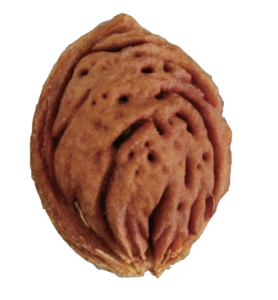

Peaches originated in China, and were introduced to Japan in the Jōmon period, approximately 6000 years ago. The peach pit, momo no shu-shi, 桃の種子, peach’s seed-of, resembles the hō-ju, 宝珠, treasure-jewel, and it has fascinated humans, perhaps because it resembles the human brain.
Women and the number three in Japan, can evoke a rather unflattering Kanji composed of three Kanji for woman, onna, 女, 姦, which is read kan, ken, kashimashii, and means wicked, mischief, seduce, rape, noisy.
In Japan, girls are especially revered on the third day of the third month according to the lunar calendar. The celebration held on that day San-gatsu,三月, Three-month, Mi-kka, 三日, is called Hina Matsuri, 雛祭り, Chick Festival. Hina means little bird like a baby chicken, and is understood to mean doll. The dolls are modelled after the Emperor and Empress and their court. There are an endless number of varieties of presentation.
Hina Matsuri is also called Momo-no-sekku, 桃の節句, Peach ’s Divide-season. Like many traditions in Japan, Momo no Sekku originated in China. It is one of the Go-sekku, 五節句, Five-divide-seasons of the lunar year, which are based on the belief that two odd numbers, which manifest the principle of Yō, 陽, Yang, positive, because they cannot be divided equally in half, when added together, create an even number which manifests the principle of In, 陰, Yin, negative.
Again, in China, on the third day of the third month, being inauspicious, rites were performed. Seemingly coincidentally, this festival was originally held on the first day the Snake of the third month, and called Jō-shi Bushi, 上巳節, Upper-snake Division. This observance usually occurred in early Spring according the Gregorian calendar, which happened when the much-loved peach trees began to bloom. On the occasion, young girls were celebrated, with hopes of they would be beautiful.
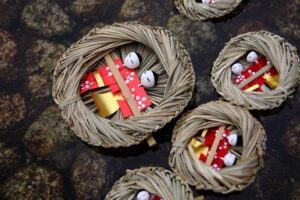
Some rituals were held at riversides, when dolls made of paper and straw were rubbed on the body as a kind of cleansing, and then put into the river to carry away disease and misfortune. These were the beginnings of the doll festival that flourished in Japan, superseding the real subject of the flowering peach trees.
The old name for lunar Kyū-san-gatsu, 旧三月, Old-three-month, is Ya-yoi, 弥生, Increase-growth. This, like other old names for the months, are used for the solar calendar months. Yayoi relates the revival of nature after winter. The zodiac sign for the third month, Tatsu-no-tsuki, 辰の月, Dragon’s-month, the animal dragon is tatsu, 龍. The Dragon time of the day is from 7 to 9 am, and is the protector of the southeast. The exact meaning of the Kanji, 辰, is ‘vibrate’.
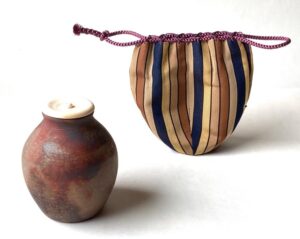
Cha-ire, 茶入, tea-receptacle, unglazed ceramic jar, su-yaki, 素焼き, uncovered-fired, in the manner of ceramics made during Ya-yoi, 弥生, Increase-growth, period, by Makoto Yabe, 誠矢部, Truth Arrow-guild, Boxford, Mass., with ivory lid and shi-fuku, 仕覆, serve-covered, silk drawstring bag with a stripe pattern of Ao-ki kan-tō, 青木間道, Green-tree interval-way.
The origin of the name yayoi, is after a location in Tōkyō, Japan, where the remains of unglazed ceramics were discovered in the Ya-yoi, 弥生, Increase-growth, neighborhood of Bun-kyō, 文京, Literary-capital, north of Tōkyō, in 1884, during excavations in a shell mound. The low-fired ceramics were made in a period from about 200 BC to 200 AD, were wheel-thrown pottery of simple undecorated forms, and occasionally made with florid adornments. This style of unglazed wares are called su-yaki, 素焼き, uncovered-fired.
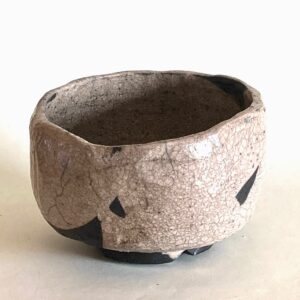
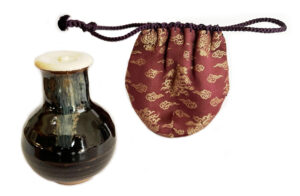
Cha-ire, 茶入, tea-receptacle, ceramic jar in the form called tsuru-kubi, 鶴首, crane-neck, with black glaze and muti-colored run, Kyō-yaki, 京焼, Capital-fired, made by Man-dai Sō-zan, 万代草山, Ten thousand-generations Grass-mountain, personal name, Ki-mi-ko, 喜美子, Joyous-beauty-child. Ms. Mandai is one of the leading potters in a field usually lead by men. The jar has an ivory lid and drawstring silk pouch, shi-fuku, 仕覆, serve-cover, with pattern of ‘Hō-un gire’, 鵬雲切, Phoenix-cloud cut, choice of Hōunsai, XV Iemoto, Urasenke. The phoenix is part of the crown of the empress. She is the phoenix and the emperor is the dragon.The dragon is closely associated with Kan-non Bo-satsu, 観音菩薩, See-sound Grass-buddha, and is often depicted with, or even riding on, a dragon.
![]()
The Buddhist guardian of the Third and Fourth months is Fu-gen Bo-satsu, 普賢菩薩, Universal-wisdom Grass-buddha. Fugen protects devotees of the Lotus Sutra, Hō-ke-kyō, 法華経, Law-flower-sutra, the only sutra that offers salvation directly for women (without first being reborn as a man), so Fugen was highly venerated by Heian noblewomen. He is commonly depicted seated on a lotus throne, and riding a white elephant. Another deity revered by women is Ben-zai-ten, 弁財天, Distinguish-value-heaven.
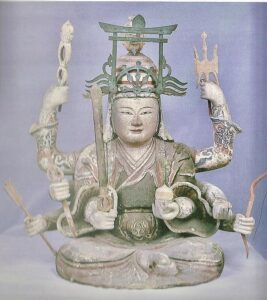
Ben-zai-ten, 弁財天, Distinguish-value-heaven, with eight arms holding various implements, including the hō-ju, 宝珠, treasure-jewel. A bronze crown in the shape of a Shintō gate, tori-i, 鳥居, bird (chicken)-reside, which was probably attached when Buddhism and Shintō were united. In Hinduism, Benzaiten was originally Sarasvati, was the goddess of wisdom, speech, music, and the arts. She is the wife of Brahma, the creator, and rules over moving waters. Temples dedicated to Benzaiten, also called Benten, are usually built on islands.
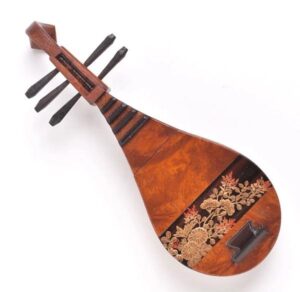
Hō-gon-ji, 本業寺, Principle-occupation-temple, is a Buddhist temple located on the sacred Chiku-bu-shima, 竹生島, Bamboo-life-island, in Bi-wa-ko, 琵琶湖, Strum-lute-lake, dedicated to the goddess Benzaiten. Chiku-bu-shima, 竹生島, Bamboo-life-island, is in Bi-wa-ko, 琵琶湖, Strum-lute-lake. The lake is like the shape of a biwa, and Benzaiten plays the biwa.
It is curious to note there is reference to the snake, hebi, and the Zodiac sign of Mi, 巳, Snake, as the white snake is strongly identified with Benzaiten, who as Sarasvati, is associated with a river, which to some resembles the serpentine aspect of rivers. Benzaiten is the only female deity of the Shichi-fuku-jin, 七福神, Seven-fortune-gods, revered in Buddhism and Shintō. Shrines dedicated to Benzaiten are frequently constructed on islets in temple grounds.
In Japanese, the Kanji for woman is onna, jō, 女, woman. Jo-sei, 女性, woman-gender, feminine. The Kanji for girl is onna no ko, 女の子, female ‘s child, girl, baby girl, daughter. Another Kanji for a female is musume, 嬢, lass, girl, Miss, daughter. Shō-jo, 少女, little-woman, is a female, a girl between the ages 7 and 17, a young lady. At the age of jū-san, 十三, ten-three, a girl becomes a woman, and shows devotion at temples dedicated to Ko-kū-zō Bo-satsu, 虚空蔵菩薩, Empty-void-keep Grass-buddha: Jū-san Mairi, 十三参り, Ten-three Temple visit. Jūsan mairi, is especially honored at the temple of Hō-rin-ji, 法輪寺, Law-ring-temple, in Arashi-yama, 嵐山, Storm-mountain. The Kanji, 参, used in mairi is also used in documents for the number three, san, 三.
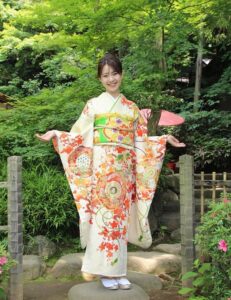
There are some conflicts regarding the traditions observing a woman’s transition at age 13. Whatever tradition, its focus has to do with onset of puberty, and a girl becoming a woman. The celebration of Jūsan-mairi permits the young woman to change the style of kimono, and this is a matter of tradition. In some places the young woman can or cannot wear a kimono that has long sleeves, furi-sode, 振袖 wave-sleeve, long sleeves.
The Kanji for furi is composed on hand/arm and the zodiac sign for the Dragon, Tatsu, 辰. Long sleeve kimono are first worn at celebrations called Coming of Age, which is quite different from Jūsan-mairi.
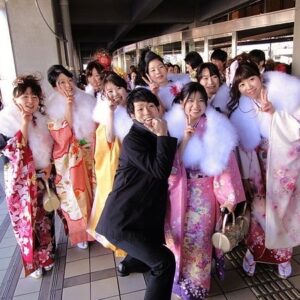
Coming of Age is an official observance held on the Sei-jin no Hi, 成人の日, Become-person’s Day, which is held on the second Monday in January, and is a National Holiday. Young people who turn 18 celebrate the occasion, that was reduced from 20, and wear kimono, or formal modern clothing, for young ladies the basic black dress, and men in suits. Some teens wear apparel that is far from traditional, including cosplay often with anime and manga influences. Such is adulthood in the world.
Coming of age means becoming and adult, otona 大人, big-person, when one may wear an adult’s kimono, called hon-dachi, 本裁ち, true-tailor. After the blessing at a shrine or temple, ceremony, one should leave, and not look back, as it may mean that the person does not want to leave childhood.
Boys becoming men are also celebrated at age 13, and it seems that boys don’t like to be photographed, so girls appear in most photos. Boys at the age of five years are not shy, and are often photographed in their overly large kimono tailored for his size, to indicate that he has room to grow big.
Three in Japanese is san, mi, mitsu, 三. The Kanji for three in legal documents is 参, which also means visit a shrine or temple, metaphorically to die, madly in love, etc. It is the Kanji that is used in the shrine visit for Jūsan-mairi.
In Japanese, as well as in some other cultures, the number three is identified with fire. For example, the Greek word for triangular, pyramid, has its origins in the word pyre, meaning fire. In symbolic geometry, the triangle is the strongest shape and form, and yet conversely is symbolic of fire which has no discernible form. The triangle pointing upward is symbolic of fire, and male, just as the triangle pointing downward is symbolic of water, and female. Fire rises up, Yō, Yang, and water falls down, In, Yin.
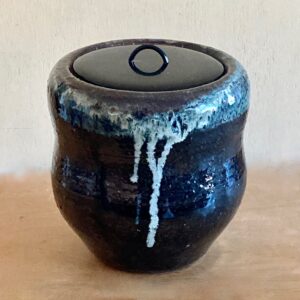
Mizu-sashi, 水指, water-indicate; stoneware vessel in the form called tan–pyō, 箪瓢, basket-gourd, inverted hyō-tan, 瓢箪, gourd-basket, with varied black glaze and white glaze on shoulder by Yōko Itō Messersmith, Kyōto. With black-lacquered wooden lid. The semi-circular tsumami, 摘み, pinch, of the lid is intended to become a complete circle being reflected in the lacquer’s mirror surface. The pictured water container made by Ms. Messersmith is the first mizusashi I acquired.
The number three is also found in the San-me-gami, 三女神, Three-woman-gods. The Sa-me-gami are: Oto-me, 乙女, Second-woman, Haha, 母, Mother, Rō-ba, 老婆, Old-crone, The Triple Goddess of Maiden, Mother, and Crone. Another identification of three women is present in the phases of the moon; waxing half-moon, full-moon, and waning half-moon. The figures are often described each as the maiden, the mother, and the crone. Often in the western world they rule one of the realms of heavens, earth, and underworld.
There is an old Japanese adage, ichi hime ni ta-rō, 一姫二太郎, one princess two big-son, which infers that a girl is born first, then a boy, so that she can attend to the boy’s needs, to become motherly.

Shio-tsuki Ya-e-ko, 塩月弥栄子, Salt-moon Increase-splendor-child was born on April 4, 1918. – March 8, 2015. She was the older sister of Hō-un-sai, 鵬雲斎, ‘Phoenix’-cloud-abstain, XV Iemoto, Urasenke. Shiotsuki Sama’s cha-mei, 茶名, Tea-name, was Sō-shin, 宗芯, Sect-wick. It should be remembered the ‘wick’ is composed of grass or plant and heart. Shiotsuki Sama’s heart was ablaze with Tea.
Shiotsuki Yaeko is pictured teaching at Showa Women’s College in Jamaica Plain, outside of Boston. She was the moving force in teaching young women at the college in Tōkyō, the importance of Chanoyu in their lives and in the significance of Tea in the modern world.
Shiotsuki Sama came to the Boston area to advise the newly founded branch of Showa Women’s College. She followed the paths lead by her mother, Ka-yo-ko, 嘉代子, Auspicious-generation-child, her father, Tan-tan-sai, 淡々斎, Light-light-abstain, XIV Iemoto of Urasenke, and her younger brother, Hōunsai, three other spectacular forces in the traditional culture of Japan.

